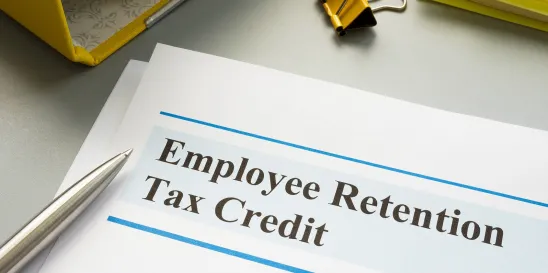Specifically, the IRS has now published the procedures for a taxpayer to file an application to participate in the ERC Voluntary Disclosure Program and publicized the benefits of participating in the ERC Voluntary Disclosure Program. Taxpayers should quickly determine whether they intend to submit an application to participate in the ERC Voluntary Disclosure Program, however, because applications must be submitted by 11:59 pm local time on March 22, 2024.
Benefits of the ERC Voluntary Disclosure Program
A taxpayer who files an application that is accepted by the IRS receives the following benefits:
- The taxpayer is required to repay only 80% of the ERC received and does not need to repay any interest received on an ERC refund.
- The 20% retained by the taxpayer is not taxable as income, and the taxpayer does not have to amend income tax returns to reduce wage expense.
- No interest or penalties are imposed on the ERC amount claimed by the taxpayer if the entire 80% of that amount is repaid to the IRS by the time that the signed closing agreement is returned to the IRS.
- The IRS will not examine the taxpayer’s employment tax returns for the tax periods resolved within the terms of the ERC Voluntary Disclosure Program.
If a taxpayer does not participate in the ERC Voluntary Disclosure Program, the taxpayer remains subject to potential interest and penalties. Unlike other IRS Voluntary Disclosure programs (such as the Offshore Voluntary Disclosure Program), acceptance into the ERC Voluntary Disclosure program and/or withdrawal of pending ERC claims does not shield an employer from potential criminal investigation and prosecution for willfully filed fraudulent ERC claims. Accordingly, criminal charges are possible in serious cases, and participation in the ERC Voluntary Disclosure Program will not exempt the taxpayer from potential criminal investigation and prosecution.
Who Can Apply to the ERC Voluntary Disclosure Program?
A taxpayer may apply to the ERC Voluntary Disclosure Program only if all of the following requirements are met:
- The ERC claimed on an employment tax return has been processed and paid as a refund, which the taxpayer has cashed or deposited (or which has been taken as a credit applied to the tax period or another tax period).
- The taxpayer now believes that it was not entitled to any amount of the ERC.
- The taxpayer is not under an employment tax audit by the IRS.
- The taxpayer is not under criminal investigation by the IRS.
- The IRS has not reversed or notified the taxpayer of its intent to reverse the taxpayer’s ERC to $0 (e.g., no letter has been received from the IRS disallowing the ERC).
- The taxpayer has not amended its employment tax return to eliminate the entire amount of the ERC claimed.
If an employer used a third-party payer (such as a professional employer organization), then the third-party payer will be the taxpayer that needs to apply to the ERC Voluntary Disclosure Program. In this case, the employer cannot apply on its own and will need to coordinate with the third-party payer to participate in the program.
How to Apply to the ERC Voluntary Disclosure Program
If a taxpayer meets the above requirements, the taxpayer can apply for the ERC Voluntary Disclosure Program by filing the below materials using the IRS’s Document Upload Tool:
- Form 15434, Application for Employee Retention Credit Voluntary Disclosure Program
- Form SS-10, Consent to Extend the Time to Assess Employment Taxes, if the taxpayer’s ERC Voluntary Disclosure Program application includes tax periods ending in 2020
As part of the ERC Voluntary Disclosure Program, the taxpayer will be required to provide information to the IRS on the Form 15434 about any advisors or tax preparers who advised or assisted the taxpayer with claiming the ERC.
Importantly, the ERC Voluntary Disclosure Program application must be filed by 11:59 pm local time on March 22, 2024.
What Happens After an ERC Voluntary Disclosure Program Application is Filed?
The IRS will review a taxpayer’s ERC Voluntary Disclosure Program application and determine whether it is accepted or rejected. If the application is accepted, the IRS will notify the taxpayer of the next steps, which will include signing and remitting a closing agreement and repaying 80% of the ERC received through the Electronic Federal Tax Payment System (EFTPS).
If a taxpayer is unable to make the full 80% repayment amount, the taxpayer may request that the IRS consider it for an installment agreement. To utilize this option, the taxpayer needs to include Form 433-B, Collection Information Statement for Businesses, in its ERC Voluntary Disclosure Program application, together with required supporting documents. A drawback of applying for an installment agreement, however, is that penalties and interest will apply from the installment agreement date. Offers in compromise are not an option under the ERC Voluntary Disclosure Program.
Alternatively, if the taxpayer’s ERC Voluntary Disclosure Program application is rejected, the IRS will notify the taxpayer accordingly, explain why the application was rejected, and offer potential solutions. In some cases, taxpayers may be able to correct an error and resubmit the application package or file an amended tax return.







 />i
/>i
